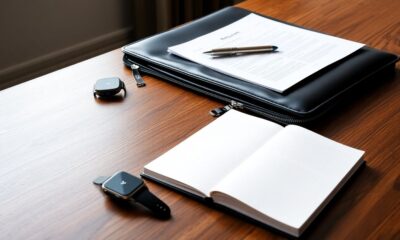Job Interview
Dressing Like THIS Will Instantly Boost Your Hiring Odds!
Harness the power of professional attire to enhance your interview success—discover what styles can elevate your chances even further!

Dressing professionally can dramatically boost your hiring odds. When you choose attire that aligns with industry standards, you signal organization and dependability to potential employers. Opt for well-fitted suits or polished business casual outfits that reflect the company culture. Avoid casual wear, loud colors, or distracting accessories, as these can hurt your chances. Remember, first impressions are formed within 15 seconds, so exude confidence with clean, wrinkle-free clothing and minimal accessories. Elevate your professional image, and you might just land that job. Want to know more about perfecting your interview attire? There's so much more to explore!
Key Takeaways
- Dress professionally according to industry standards, opting for tailored outfits that convey competence and attention to detail.
- Choose neutral colors and conservative styles to create a polished appearance that aligns with company culture.
- Avoid casual attire like jeans and sneakers; instead, select well-fitted dress pants or skirts and polished shoes.
- Maintain clean, wrinkle-free clothing and groom yourself neatly to make a strong first impression within the crucial first 15 seconds.
- Invest in quality accessories that enhance your outfit without overshadowing your qualifications, such as simple jewelry and a polished watch.
Significance of Professional Attire

When it comes to job interviews, the significance of professional attire can't be overstated. Dressing formally not only enhances your image but gives you a competitive edge over other candidates. A polished, neat appearance communicates that you're organized and dependable, traits that employers highly value. In fact, the ongoing trend towards casual workplace attire highlights the importance of choosing the right style for your interview context.
When you align your attire with workplace standards, you also demonstrate respect for the opportunity at hand.
Choose simple, professional accessories and hairstyles—they shouldn't distract from your overall presentation. Personal hygiene is essential, too. Clean nails and hands, along with minimal fragrances, can make a positive impression.
It's also important to reflect on the specific workplace environment. For casual workplaces, professional-looking casual attire, like dark jeans and blouses, is appropriate. In business casual settings, opt for dress pants and button-down shirts. If you're headed to a formal workplace, dark suits or tailored dresses work best.
Researching the company's dress code through their social media can provide valuable insights. Remember, when in doubt, it's always better to be overdressed than underdressed. Your attire can set the tone for the interview, so make it count!
How Attire Affects Perception

Your attire plays an essential role in shaping perceptions during the hiring process. First impressions are formed quickly, often within just 15 seconds, and a staggering 55% of how someone perceives you is based on your appearance. When you dress well and groom yourself properly, you send positive signals about your professionalism. A polished, confident look enhances your overall appeal to potential employers.
Research shows that formal attire is associated with higher competence and credibility. Recruiters tend to favor conservative clothing, as it conveys professionalism and reliability. When you choose formal attire, it enhances your perceived intelligence and trustworthiness. Appropriate dressing provides a competitive edge in job hunting, making it even more crucial in today's job market.
On the flip side, wearing the wrong clothes can greatly hurt your chances; 37% of managers have decided against a candidate based solely on their outfit.
Even in more casual work environments, dressing professionally can leave a lasting impression. Aligning your clothing choices with industry standards is essential. Attractive, well-dressed individuals are more likely to receive callbacks for second interviews, while incorrect attire can overshadow even the strongest qualifications.
Understanding Dress Code Policies

Understanding dress code policies is essential for maneuvering the professional landscape effectively. These policies outline expectations for employee attire, aiming to maintain a professional image that reflects the company’s culture and values. They apply to all employees, ensuring a uniform representation, especially during client and visitor interactions. Having a clear understanding of dress code policies allows employees to make informed decisions about their attire for commanding respect in the workplace. It also helps to create a sense of unity and cohesion among team members, fostering a professional and cohesive work environment. By adhering to these policies, employees can demonstrate their commitment to upholding the company’s standards and projecting a positive brand image.
You'll typically encounter various dress codes, from business formal to casual. Business professional attire usually involves suits and ties, while business casual allows for slacks and simple jewelry. Knowing the distinctions is vital, as requirements can vary based on your role and client interactions.
Your appearance matters, so be sure to stay clean and well-groomed, avoiding workout or outdoor clothing. It's important to wear work-appropriate attire that's not revealing or in poor condition, with no visible rips or tears. Employee appearance plays a crucial role in how the company is perceived by clients and visitors.
Additionally, steer clear of clothing with offensive prints.
Best Interview Attire Practices

Choosing the right interview attire can greatly impact your chances of making a good impression. Start by researching the company culture. Determine if they lean toward formal, business casual, or a more creative dress code. Check their website, social media, or ask current employees for insights. Adjust your outfit based on the industry and the specific role's level of formality.
Next, verify your clothes fit well. Ill-fitting clothes can be distracting, so opt for pieces that allow comfortable movement. Breathable fabrics are a must, especially if the weather is warm. When preparing for virtual interviews, remember to dress professionally from head-to-toe to maintain a polished appearance even on camera. Consider incorporating natural materials into your attire for a more authentic look.
Grooming is equally important. Make sure your attire is clean, wrinkle-free, and well-pressed. Avoid excessive cologne or perfume, and keep your hair, makeup, and jewelry simple and professional. Polished shoes are a must, so verify they're in good condition.
Stick to conservative colors and styles. Black, gray, or navy are safe choices for suits and dresses. Avoid flashy or overly trendy pieces, and opt for closed-toe shoes. Matching your jacket with your slacks or skirt helps create a cohesive look that exudes professionalism.
Building a Professional Wardrobe

A well-curated professional wardrobe is essential for making a strong impression in the workplace. Start by researching your industry's dress code standards through social media, company websites, and LinkedIn. This helps you understand what's expected and allows you to dress slightly more formal initially, adjusting as needed. Additionally, utilizing on-campus resources can provide valuable assistance in selecting suitable attire. Developing a growth mindset towards your wardrobe choices can also enhance your confidence during interviews.
Focus on building your wardrobe with essential items. Here's a quick guide:
| Essential Items | Tips for Selection |
|---|---|
| Signature blazer | Choose neutral colors for versatility |
| Quality dress pants | Guarantee a good fit for comfort |
| Professional dresses | Look for styles that suit your body type |
| Dress shoes | Invest in both black and brown |
Consider budget-friendly options like thrift shopping or clothing swaps to refresh your wardrobe without breaking the bank. Mix and match your pieces, and don't hesitate to add a personal touch through accessories. By investing in quality items and being mindful of the workplace culture, you'll build a professional wardrobe that enhances your confidence and boosts your hiring odds.
Sector-Specific Dress Expectations

When you're preparing for an interview, understanding sector-specific dress expectations can make a big difference. In financial services, a polished, formal look is often required, while tech industries might lean towards smart casual attire. Additionally, adhering to dress code policies can help you align with the company's culture and values. Manufacturing roles may focus on practicality, so knowing the norms for each sector helps you present yourself appropriately.
Financial Services Dress Codes
In the financial services sector, dress codes play a crucial role in shaping professional perceptions and expectations. Traditional attire typically includes a well-fitted suit—either a jacket and pants or a jacket and skirt—made from dark colors like black, charcoal, or navy blue.
Men should wear ties with conservative patterns, while polished shoes are a must for everyone. Women can opt for pumps, flats, or stylish heels. Suits are standard attire in the banking industry and investing in quality options shows professionalism. Additionally, maintaining a professional appearance can enhance your credibility, paralleling the importance of maximizing IRA contributions for financial stability.
However, many firms are easing up on dress codes, allowing for business-casual attire, especially in client-facing roles. Companies like J.P. Morgan Chase permit casual pants, skirts, and appropriate tops.
Remember, business casual isn't the same as weekend casual, so keep it polished. When meeting clients, dress at the same level or slightly above to maintain professionalism. Full suits remain the norm in investment banking, while financial advisors may have more flexibility based on their clientele.
Be mindful of specific business settings—what works in one firm mightn't in another. Ultimately, your comfort and confidence in your attire can greatly influence your hiring odds and client attraction.
IT Sector Attire Norms
Maneuvering attire norms in the IT sector can greatly influence your hiring prospects. When preparing for tech interviews, opt for a button-down shirt or blouse paired with dark, fitted pants or chinos.
While a blazer or jacket isn't mandatory, it's recommended for a polished look. Choose closed-toe shoes, ensuring they're polished if appropriate. Keep jewelry minimal—bold or flashy items can distract from your professional image.
In some tech companies, dark jeans are acceptable, but collared shirts are preferred over T-shirts. Avoid flip-flops or sandals, and consider layering with a cardigan or office sweater. Confidence is key in selecting your clothing to ensure you present the best version of yourself.
Patterned socks can subtly showcase your personality without overwhelming your outfit. Underdressing can hurt your chances, so steer clear of shorts, tank tops, leggings, or clothes with holes.
Hats and open-toe shoes are generally not advisable, and make sure everything you wear is wrinkle-free and well-maintained. It's always safer to be slightly overdressed than underdressed.
Lastly, research the company culture to tailor your attire. Large software firms may embrace casual styles, while hardware companies tend to lean conservative.
Observing current employees can provide valuable insight into what's appropriate.
Manufacturing Industry Expectations
Understanding the dress expectations in the manufacturing industry is essential for making a strong impression during interviews or within the workplace. You want to convey professionalism while prioritizing safety. Clothing must promote comfort and safety in factory settings to ensure effective job performance and compliance with best practices.
Here's a quick overview of what to keep in mind:
| Dress Code | Safety Gear | Professional Appearance |
|---|---|---|
| Neat, clean clothing | Reliable work shoes | Tidy and sharp look |
| No torn or frayed items | Gloves and hard hats as needed | Business casual for meetings |
| Avoid inappropriate imagery | Short-sleeve shirts preferred | Minimal jewelry and fragrances |
| Durable pants recommended | Avoid baggy clothing | Change clothes for different areas |
Common Attire Mistakes to Avoid

Many job seekers make essential attire mistakes that can undermine their chances of landing a position. One common error is dressing too casually. If you're interviewing in formal industries like finance or law, avoid jeans, sneakers, and relaxed clothing. Showing up in shorts or flip-flops sends the wrong message.
In addition, be cautious about your color choices. Loud, distracting colors or flashy prints can divert attention away from your qualifications. Stick to neutral or muted colors that convey professionalism.
Revealing or unprofessional clothing is another pitfall. Low-cut shirts, short skirts, or anything too clingy can create a distracting impression. Aim for knee-length skirts and avoid leggings unless paired appropriately. Industry norms can significantly influence what is considered appropriate attire, so it's crucial to tailor your outfit to the specific sector.
Lastly, don't overlook grooming and fit. Messy hair or unkempt appearance can negatively affect your first impression. Guarantee your clothes are clean, pressed, and well-tailored. Avoid white or athletic socks, and choose shoes that are both stylish and comfortable.
The Role of Accessories

When you choose your accessories, think about how they reflect your professional image. Simple and appropriate pieces can enhance your outfit without overshadowing your qualifications. Subtle jewelry is particularly effective in keeping the focus on your skills and experience during an interview.
Choosing Appropriate Accessories
Choosing the right accessories can greatly enhance your professional appearance, especially during a job interview. Stick to small, understated pieces of jewelry that won't overshadow your outfit. Classic stud earrings, a delicate necklace, or a slim bracelet can add just the right touch. Avoid large, flashy, or noisy jewelry that might distract from your qualifications.
When selecting accessories, match them to the style and formality of your attire. For formal settings, conservative options like pearl earrings or a simple watch are ideal. In business-casual environments, you can introduce tasteful pendants or bracelets that reflect your personality while remaining professional. Researching the company culture will help you align your choices accordingly. Understanding the company dress code is essential for making appropriate accessory selections. Additionally, just as in music where collaborative creativity enhances the final piece, your accessories can complement your overall look and show your attention to detail.
Make certain your accessories don't create distractions. Skip jewelry that makes noise or interferes with your movements. A clean, polished look is essential, so confirm your jewelry is in good condition, your nails are well-groomed, and other accessories like watches are tidy.
Finally, avoid excessive or flashy pieces to keep the focus on your qualifications, presenting yourself as a polished candidate ready for the job. It’s essential to create a professional and put-together image during any job application process. This means avoiding distracting or attention-grabbing accessories that may take away from your qualifications. By keeping your look simple and refined, you allow your skills and experience to take center stage. Additionally, keeping communication with the employer polite and professional is crucial, as well as being prepared to discuss average waiting time statistics for the industry during an interview.
Impact on Professional Image
The right accessories can greatly impact your professional image, conveying messages of success and attention to detail. Luxury accessories, like designer watches or sleek leather briefcases, can transform your outfit from ordinary to extraordinary. They evoke sophistication and elegance, setting you apart from the crowd and creating a powerful impression on others. Statistics show that individuals with a polished appearance are often perceived as more competent by their peers. Additionally, the Law of Attraction suggests that projecting a successful image can attract further success into your life.
When you wear high-end accessories, you boost your confidence and present a refined sense of aesthetics. This attention to detail enhances your credibility, making you appear serious, reliable, and successful. Additionally, luxury items can spark interest, opening up networking opportunities due to their distinctive nature.
However, it's crucial to balance sophistication with subtlety. Choose simple earrings or classic hoops that enhance your look without overwhelming it. A delicate chain necklace or a timeless string of pearls can elevate your appearance without being distracting. Stylish, well-designed bags can add elegance while keeping your professional demeanor intact.
Lastly, always align your accessories with workplace culture. Research the company's dress code to guarantee your choices complement the environment, whether it's formal, business casual, or creative. Clean, polished accessories will help maintain a professional appearance.
Tips for Dressing Confidently

Finding the right outfit can greatly impact your confidence during an interview. When you dress well, you not only feel good but also project a positive image to potential employers.
Here are some tips to help you dress confidently:
- Research the Company's Culture: Understand the industry's dress norms and ask current employees about the dress code. Aim to be slightly more formal than the usual attire, as understanding the culture can aid in making a positive first impression.
- Choose Appropriate and Comfortable Attire: Pick clothes that fit well and allow for easy movement. Classic pieces like black trousers or skirts often work best, paired with professional shoes.
- Pay Attention to Accessories and Grooming: Keep your accessories minimal and avoid anything too flashy. Make sure your hair is neat, and your nails are clean. A nice watch or belt can add a polished touch.
- Dress to Inspire Confidence: Wear outfits that make you feel empowered. The right clothing can influence how others perceive you, so choose a style that aligns with the professional image you want to convey.
Frequently Asked Questions
What Colors Are Most Appropriate for Professional Attire?
When choosing colors for professional attire, stick to classic options like navy blue, black, and gray.
These colors convey trust, professionalism, and analytical skills, making them ideal for interviews. White shirts are great for a clean look, while avoiding bright or bold colors helps maintain a serious tone.
How Does Cultural Background Influence Professional Dress Expectations?
Cultural background plays a significant role in shaping professional dress expectations. When you understand these influences, you can navigate workplace attire more effectively.
For instance, if you're from a culture that values modesty, you might opt for longer sleeves and conservative cuts. Conversely, in creative fields, you might express your individuality through bold choices.
Recognizing and respecting diverse dress norms fosters inclusivity and can enhance your professional relationships in a multicultural environment.
Can Wearing Accessories Impact Hiring Decisions?
Yes, wearing accessories can impact hiring decisions. When you choose the right accessories, they can enhance your professional look and show attention to detail.
However, if they're too flashy or distracting, they might overshadow your qualifications. It's important to select simple, elegant pieces that align with the company culture, as this illustrates your understanding of the workplace.
Is It Acceptable to Wear Open-Toed Shoes in Interviews?
Did you know that 55% of first impressions come from appearance? When it comes to interviews, open-toed shoes generally aren't a safe choice. They can appear too casual and distract from your professional image.
In traditional industries, closed-toe shoes are often mandatory. If you're applying in a creative field, check the dress code first.
Prioritize comfort and quality, ensuring your footwear aligns with the company culture to make a strong impression.
How Do Personal Styles Align With Professional Dress Codes?
Personal style can align with professional dress codes by incorporating subtle elements that reflect who you're while adhering to industry standards.
You can choose unique accessories or well-tailored pieces that maintain professionalism. Understanding your company's culture is essential; for example, formal industries might require a more polished look, while creative fields may allow for relaxation.
Ultimately, your choices should enhance your confidence without compromising the expectations of the workplace.
Conclusion
In the grand theater of job interviews, your attire is your costume, setting the stage for success. By dressing thoughtfully, you not only reflect professionalism but also boost your confidence—a silent partner in your performance. Remember, just as a well-rehearsed actor captivates an audience, your polished appearance can leave a lasting impression. So, embrace the power of your wardrobe, avoid common pitfalls, and step into that interview ready to steal the spotlight. You've got this!
Emmeline is the backbone of our content creation team, bringing complex psychological concepts to life with clarity and empathy. As our Expert Writer, she crafts engaging, insightful articles that guide readers through the intricacies of personality assessments and what they reveal about the human condition. Her passion for psychology and personal development shines through in every piece she writes.
Job Interview
Beat The Heat & Still Impress: Summer Interview Attire Hacks!
Optimize your summer interview look with stylish attire hacks that keep you cool; discover essential tips to impress your interviewers effortlessly!

You can beat the heat while impressing your interviewers by choosing the right attire. Opt for lightweight fabrics like cotton and linen to stay cool, and go for tailored shorts, knee-length dresses, or smart-casual trousers paired with light blouses. Pastel colors reflect heat and exude professionalism. Don't forget to groom yourself neatly and choose stylish but comfortable shoes that align with your outfit. Arriving prepared boosts your confidence, letting you focus on showcasing your skills. Want more tips on nailing that summer interview look? There's plenty of helpful advice just ahead!
Key Takeaways
- Choose lightweight fabrics like cotton and linen to stay cool while maintaining a professional appearance during summer interviews.
- Opt for tailored shorts with blazers or knee-length dresses to balance comfort and professionalism in hot weather.
- Prioritize well-fitting, clean outfits to enhance confidence and demonstrate attention to detail, crucial for making a positive first impression.
- Select stylish yet comfortable footwear, such as loafers or low heels, to ensure mobility and a polished look without sacrificing comfort.
- Prepare your outfit the night before to reduce last-minute stress and ensure you're ready to impress in the heat.
Overview of Summer Interview Attire

When preparing for a summer interview, you should focus on three key elements: comfort, professionalism, and appropriateness. The right interview outfits can make all the difference in how you present yourself. Since summer heat can be intense, choose breathable materials that keep you cool without sacrificing your professional look. Lightweight fabrics like cotton or linen are excellent choices.
Traditional workwear can feel stifling in warm weather, so consider lighter, more casual options that still convey professionalism. A light blouse paired with breathable trousers or a skirt strikes the perfect balance. While you want to stay comfortable, it's essential to steer clear of excessively casual items like crop tops or baseball caps, which can undermine your professional appearance.
Selecting Appropriate Outfits

Choosing the right outfit for your summer interview involves more than just picking something lightweight. You'll want to take into account the job role and the organization's dress code to guarantee your attire aligns with expectations. This not only shows respect but also demonstrates your understanding of the company culture.
Evaluate factors like travel time, outdoor temperature, and the interview location's climate. Selecting clothing that keeps you comfortable is key. Avoid excessively casual items, such as baseball caps and crop tops. Instead, opt for a professional outfit made from breathable fabrics like cotton, linen, or lightweight blends. These materials help you stay cool while maintaining a polished appearance. Additionally, consider incorporating essential oils for stress relief to help maintain a calm demeanor before your interview.
If you're unsure about the dress code, don't hesitate to ask the company beforehand. It's better to clarify than risk misalignment in your attire choices. Finally, prioritize comfort in your outfit selection. A well-fitting and breathable outfit not only enhances your focus but also boosts your confidence during the interview. By choosing wisely, you can beat the heat and impress your interviewers, setting a positive tone for your summer interview.
Summer Outfit Ideas

Often, summer interviews call for a balance between professionalism and comfort, so it's essential to reflect on outfit ideas that fit this dual requirement. Lightweight fabrics like linen and cotton blends are your best friends; they guarantee breathability while keeping your professional style intact.
If you're heading to a less formal interview, consider pairing tailored shorts with a blazer. This combination strikes the right note between polished and comfortable. Alternatively, knee-length or midi dresses made from breathable materials offer an elegant option that keeps you cool without sacrificing sophistication.
For a versatile option, smart-casual trousers paired with light blouses can create a balanced outfit that's perfect for summer interviews. Don't forget about accessories; keep them minimal to maintain focus on your interview attire. Comfortable shoes, like loafers or low heels, will help you navigate the day with ease while looking put-together. Additionally, adopting a growth mindset can enhance your confidence, allowing you to handle the interview's challenges effectively.
With these summer outfit ideas, you can confidently step into your interview, showcasing both your professionalism and your ability to keep cool under pressure.
Tips for Choosing Clothes

Five key tips can help you select the perfect attire for your summer interview. To keep cool and composed, focus on lightweight, breathable fabrics like cotton, linen, and rayon. These materials not only allow air circulation but also maintain a polished look.
| Tip | Details |
|---|---|
| Fabric Choice | Opt for lightweight, breathable fabrics. |
| Color Selection | Choose light or pastel colors to reflect heat. |
| Fit Matters | Guarantee a proper fit for comfort and professionalism. |
| Layer Wisely | Incorporate light cardigans or blazers for AC. |
| Comfortable Shoes | Prioritize loafers or low wedges for ease of movement. |
When you pick your outfit, remember that lighter colors can help you avoid sweat marks, keeping you looking sharp. A well-fitted ensemble enhances professionalism and allows for better comfort during long interview days. Also, since air conditioning can be chilly, layering is a smart move. Finally, choose comfortable shoes that match the formality of the interview, guaranteeing you can walk in confidence. Additionally, consider how different brewing methods can affect your caffeine levels to help you stay alert during the day.
Importance of First Impressions

First impressions happen in the blink of an eye, often within the first 30 seconds of meeting someone. When you dress professionally for your interview, you show respect for the opportunity and boost your own confidence, which can lead to better performance. Remember, how you present yourself can greatly influence the hiring manager's perception of you and your fit within the company culture. Furthermore, establishing clear boundaries can help you maintain professionalism and comfort during the interview process.
Instant Perception Formation
When you walk into an interview, the impression you make in those initial seconds can set the tone for the entire conversation. Your interview clothes play a pivotal role in crafting that first impression, especially in casual summer settings. Dressing appropriately not only signals professionalism but also showcases your understanding of the company's culture.
Here's a quick overview of how different attire can influence perceptions:
| Attire Type | Perception Impact | Suitable For |
|---|---|---|
| Business Formal | Highly professional | Corporate interviews |
| Smart Casual | Balanced professionalism | Creative industries |
| Casual Summer | Relaxed yet competent | Startups or informal roles |
| Overly Casual | Lack of respect for the process | Rarely suitable |
| Well-fitted & Clean | Confidence and attention to detail | Any setting |
Research shows that candidates who present themselves professionally are often favored over those who appear too casual, regardless of qualifications. Invest time in selecting the right outfit; it'll boost your confidence and leave a lasting positive impression. Additionally, regular maintenance of email lists can enhance your communication skills, which may also be beneficial during networking opportunities.
Professionalism Reflects Respect
Making a strong first impression is essential in an interview, and your attire plays a significant role in that moment. Research shows that a professional outfit can dramatically influence an interviewer's perception, often impacting hiring decisions within seconds. When you choose your clothing, consider the company's dress code and culture. Aligning your attire with these values shows respect for the organization and the interview process.
Opt for a polished look that fits into the business casual category, as this strikes a balance between professionalism and comfort, especially during the summer heat. A well-chosen outfit not only conveys seriousness but also helps you feel more confident and focused. When you present yourself professionally, it allows you to engage more effectively with the interviewer, showcasing your qualifications without the distraction of inappropriate attire.
Confidence Enhances Performance
A strong sense of confidence can transform your interview experience and enhance your performance. You might not realize it, but first impressions form in mere seconds. Dressing in a professional outfit not only reflects your respect for the opportunity but also sets the tone for how the interviewer perceives you. When you wear something that aligns with the company culture, it can greatly boost your confidence, making you feel more at ease.
Research shows that candidates who dress well are often viewed more favorably by interviewers. This is because a carefully chosen outfit can empower you, improving your communication and body language during the interview. When you feel confident in what you wear, you project an air of self-assuredness that can positively influence the entire interaction. Additionally, spiritual principles can serve as reminders of your inner strength and resilience, helping you to approach the interview with a calm and focused mindset.
Grooming and Hygiene Essentials
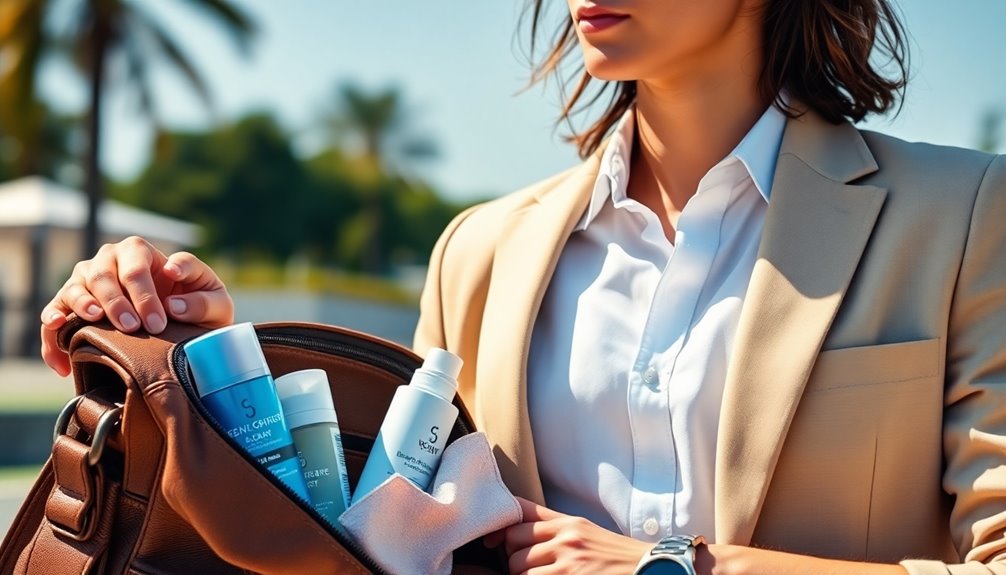
When you step into an interview, your grooming speaks volumes about your professionalism. Make sure your hair is neat and styled appropriately, your nails are clean and well-groomed, and opt for subtle fragrance choices that won't overwhelm. These small details can help you create a polished image that leaves a lasting impression.
Neat Hair and Style
To create a polished appearance for your summer interview, focus on neat hair and style that reflect professionalism. Styles like low chignons, ponytails, or braids are ideal, as they keep your hair off your face and neck, helping you stay cool despite the summer heat. Make certain your hair is clean and styled according to your industry's standards; this attention to detail can greatly boost your confidence and make a strong first impression.
When it comes to makeup, aim for a fresh, natural look. A tinted moisturizer paired with neutral lip colors will keep you looking professional without the risk of heavy products melting away in the heat.
Regular grooming is essential, so pay attention to every detail. Neat hair, combined with clean and well-kept nails, reflects your professionalism and commitment to presenting yourself well.
Finally, opt for subtle, light fragrances to maintain a pleasant scent without overwhelming anyone in close quarters. Avoid strong perfumes, especially in warm weather, to prevent discomfort during the interview. By following these grooming tips, you'll convey a polished appearance that leaves a lasting impression. Additionally, consider the impact of proper toilet maintenance on your overall hygiene, as clean and well-maintained restrooms are crucial in professional environments.
Clean, Well-Groomed Nails
Attention to grooming extends beyond hair; clean, well-groomed nails play a significant role in your overall professional appearance. When you walk into an interview, your nails can subtly communicate your attention to detail and professionalism. If they're dirty or unkempt, it can leave a negative impression, overshadowing your qualifications.
To maintain a polished look, choose neutral or subtle nail polish shades instead of loud colors or intricate designs. This approach keeps your appearance professional and helps you stand out for the right reasons. Regularly trimming and filing your nails is essential to prevent snagging or breakage, ensuring they always look neat.
Proper nail hygiene is vital, too. Make sure your nails are clean and free from dirt, which reflects personal care and professionalism. If you want an extra touch, consider a simple manicure, but make sure it aligns with the industry standards for professionalism. Additionally, incorporating cruelty-free products into your nail care routine can further demonstrate your commitment to ethical beauty standards.
Subtle Fragrance Choices
While fragrance can enhance your overall impression during an interview, it's crucial to choose subtle options that won't overwhelm your interviewer. Opt for light scents, like citrus or floral fragrances, which are invigorating and less likely to be overpowering in warm weather. These subtle fragrances can subtly elevate your presence without becoming a distraction.
When selecting your fragrance, aim for those with a limited number of notes. Strong scents can easily overwhelm the senses, so keep it simple and light. Applying your fragrance to pulse points, such as your wrists and behind your ears, allows the scent to emanate gently, providing an invigorating presence throughout your interview.
Instead of heavy perfumes, consider body sprays or deodorants that offer light, pleasant scents. This way, you maintain a professional aura while ensuring your fragrance is subtle and inviting. Also, avoid applying fragrance right after showering, as the heat from your body can amplify the scent. Instead, give it a few minutes before your interview to find the perfect balance. By following these tips, you can confidently present yourself while keeping your fragrance choices discreet and effective.
Preparing for Interview Day

On the evening before your interview, lay out your outfit to guarantee it's clean, pressed, and ready to wear. This simple act reduces last-minute stress and helps you look and feel confident. Preparing for interview day is all about being organized and calm. Here are four essential items to pack in your professional bag:
- Copies of your resume – You never know who might need one!
- A notepad and pen – Great for jotting down notes or questions during the meeting.
- An umbrella or light jacket – Weather can be unpredictable; staying comfortable keeps you cool.
- Transportation plan – Arriving early lets you check your appearance and gather your thoughts.
Consider taking a breather at a nearby coffee shop or restaurant before your interview. This will give you a moment to relax, mentally prepare for your questions, and reduce anxiety. Prioritize comfort over cost when planning your travel, and allow extra time to ascertain you arrive without panic. Additionally, being prepared with strong communication skills can significantly enhance your chances of making a positive impression. With these tips, you'll be all set to impress while staying cool in the summer heat!
Final Touches for Success
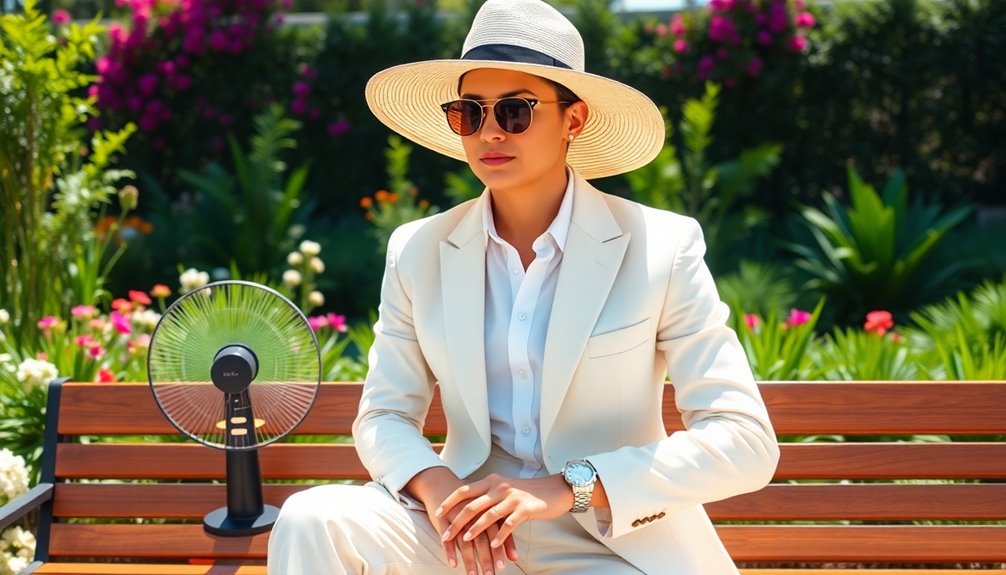
As you gear up for your interview, don't overlook the final touches that can elevate your overall presentation. To maintain a polished appearance, make certain your outfit is clean, pressed, and free of wrinkles. This attention to detail greatly impacts your professional image, especially during a summer interview.
Arrive early to allow time for final grooming checks. Take a moment to adjust your hair or makeup, making sure you feel confident and look your best before the interview starts. Lightweight and breathable undergarments can enhance your comfort and help you avoid overheating, allowing you to focus on the conversation rather than discomfort.
Consider carrying a portable fan or cooling towel to manage heat before entering the interview space. This guarantees you arrive feeling fresh and composed. Finally, stay hydrated by drinking water prior to the interview. Staying hydrated not only boosts your energy levels but also aids in maintaining focus and clarity during the discussion. By incorporating these final touches, you'll set yourself up for success, making a lasting impression on your interviewers.
Classic Attire Ideas

When it comes to summer interview attire, choosing the right outfit can make all the difference in your confidence and comfort. You want to impress while staying cool, so here are some classic outfit ideas for your summer job interview.
- Lightweight Fabrics: Opt for linen or cotton blends to keep breathability in mind while looking polished.
- Tailored Light-Colored Suit: A light suit paired with a smart blouse and knee-length skirt strikes a perfect business formal look.
- Chic Midi Dress: Consider a midi dress in breathable materials that allows for movement and maintains elegance, suitable for various interview settings.
- Smart-Casual Pairing: Combine structured tops with tailored shorts for a smart casual look that balances professionalism and comfort.
Finish your outfit with stylish yet comfortable shoes, like loafers or low heels, ensuring ease of movement. Remember, the right summer interview attire not only helps you look good but also boosts your confidence, allowing you to focus on showcasing your skills and personality.
Frequently Asked Questions
What Is Appropriate to Wear to an Interview in the Summer?
When you're heading to a summer interview, focus on lightweight, breathable fabrics like cotton or linen. Go for light colors to keep cool and minimize sweat visibility. A tailored option, like an unlined suit or a smart blouse with an ankle-length skirt, can keep you looking polished. Avoid overly casual items like flip-flops, and choose closed-toe shoes or loafers for a balance of professionalism and comfort. Always consider the company culture too!
Can I Wear Shorts to an Interview if It's Hot?
You might think wearing shorts to an interview is a smart choice when it's hot, but it can come off as unprofessional. While tailored shorts paired with a polished top could work in a casual environment, it's risky. Always research the company's dress code first. Instead, try lightweight trousers or a knee-length skirt. Staying cool is important, but maintaining a professional appearance is essential for making a good impression.
What Shoes to Wear to a Summer Interview?
When choosing shoes for a summer interview, opt for loafers or closed-toe flats made from breathable materials. They'll keep you comfortable and professional during your interview. If you prefer heels, stick to open-toed options that look polished and fit the company's dress code. Avoid casual footwear like sandals or flip-flops, as they can undermine your professional image. Look for shoes with cushioned insoles and neutral shades for a versatile and stylish choice.
What to Wear to an Interview When You Don T Have Nice Clothes?
Imagine stepping into the interview room, confidence radiating from your polished appearance. If you don't have nice clothes, don't worry! Borrow or rent a professional outfit, or explore thrift stores for hidden gems. Focus on versatile pieces like a tailored blazer paired with items you already own. Accessorize minimally but effectively, and make sure everything fits well. A clean, neatly pressed look can outshine expensive brands, leaving a lasting impression.
Conclusion
In the heat of summer, think of your interview attire as the icing on a cake—it's the finishing touch that makes a lasting impression. Just like a well-decorated cake draws people in, a polished outfit can set you apart from the competition. Remember, your confidence shines brightest when you feel comfortable and put together. So, dress smart, stay cool, and let your personality take center stage. You've got this!
Felicity, our Author, pens in-depth articles and guides that delve into the heart of personal discovery. Her narrative-driven approach weaves together theory, practice, and personal anecdotes, making the journey of self-exploration both relatable and inspiring. Felicity’s contributions help illuminate the path for those seeking a deeper understanding of themselves and their relationships.
Job Interview
Essential Interview Questions Every Fresher Faces
Wondering what key interview questions every fresher should prepare for? Discover the insights that can help you stand out in your next interview.

As a fresher, you'll likely encounter key interview questions that test your readiness. Start with a self-introduction that highlights your background and relevant education. Be prepared to discuss your strengths and weaknesses—providing examples helps. Employers often ask about your career goals, so align them with the company's mission. You'll need to demonstrate teamwork experience, conflict resolution skills, and how you handle stress. Finally, always have insightful questions for the interviewer to show your interest. Mastering these areas can set you apart, and you might discover even more insights ahead.
Key Takeaways
- Be prepared to introduce yourself by sharing your background, education, and relevant experiences in a concise manner.
- Highlight your strengths with specific examples that demonstrate how you can contribute to the role or organization.
- Acknowledge a genuine weakness and discuss the steps you've taken to improve it, showcasing self-awareness and growth.
- Share your career goals and how they align with the company's objectives, emphasizing your desire for leadership and impactful contributions.
- Describe a past teamwork experience using the STAR method, focusing on your role, communication strategies, and how challenges were overcome collaboratively.
Self-Introduction

A strong self-introduction sets the tone for your interview, so it's crucial to make a good impression.
Begin by briefly sharing your name and background, including where you're from. Highlight your educational qualifications, emphasizing any relevant coursework or projects that relate to the job.
Next, mention any internships, volunteer work, or experiences that showcase your skills and commitment. Keep it concise and targeted, avoiding unnecessary details.
It's also helpful to touch on key personal traits that make you a great fit for the role, such as being a quick learner or a team player.
Strengths and Weaknesses
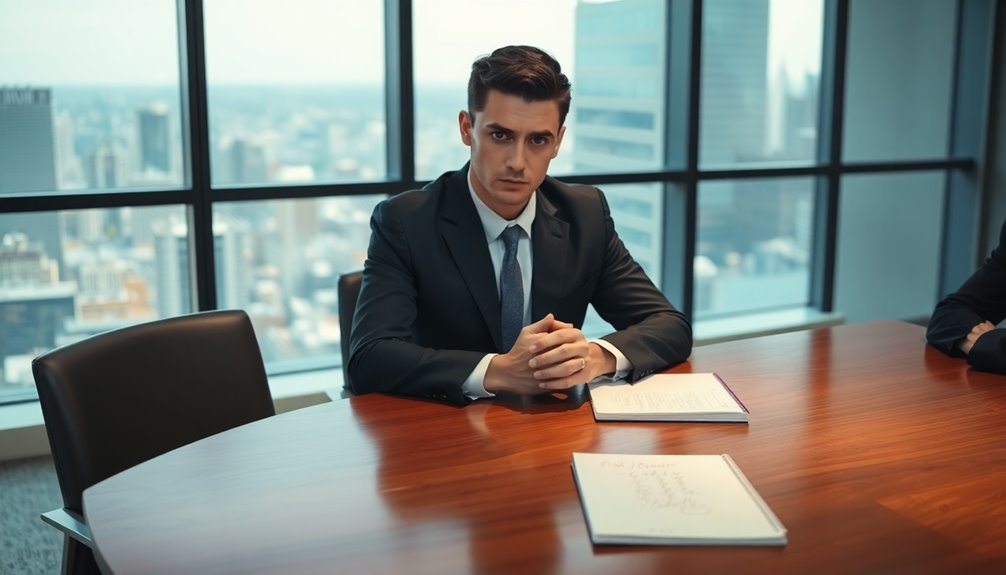
Highlighting your strengths and addressing your weaknesses effectively can greatly impact your interview performance.
When discussing your strengths, focus on specific skills that align with the job description. Use the formula: Strength + Context + Story. For instance, if you're a strong communicator, share an example of how you led a team project successfully.
When it comes to weaknesses, honesty is key. Identify a genuine area for improvement, like time management, and explain the steps you're taking to enhance it. Use the formula: Weakness + Context + Improvement.
This shows your self-awareness and commitment to growth. By articulating both strengths and weaknesses clearly, you demonstrate your readiness for the role and a proactive mindset. Additionally, maintaining mental clarity through techniques such as mindfulness can help you stay focused during interviews.
Career Goals

Often, interviewers want to know where you see yourself in the future to gauge your ambition and fit within the company's growth trajectory.
When discussing your career goals, aim to align your aspirations with the organization's objectives. This shows that you're not just focused on personal advancement but also on contributing to the company's success.
Here are some points to evaluate when formulating your response:
- Aspiring to take on leadership roles within the company.
- Seeking opportunities to develop specialized skills in your field.
- Planning to contribute to impactful projects that align with company values.
- Aiming to mentor junior colleagues and foster team development.
- Envisioning yourself as an industry expert by continuing education and networking.
Motivation for the Role
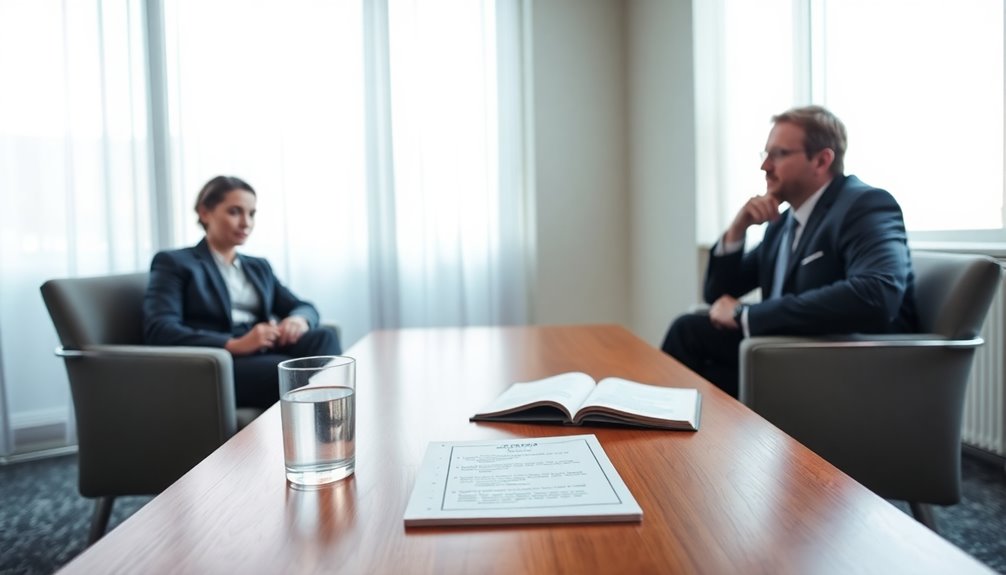
Understanding your career goals sets the stage for discussing your motivation for the role. You should research the company's mission and values to guarantee they align with your own.
Think about what excites you about this specific position and how it contributes to your long-term aspirations. For instance, if you're passionate about education, express your enthusiasm for helping students through their journey.
Be ready to explain why you believe this role is a perfect fit for you, showcasing any relevant experiences or skills that connect to the job.
Teamwork and Collaboration

During your interview, discussing teamwork and collaboration can showcase your ability to work effectively with others. Employers value candidates who can integrate into their teams and contribute positively.
Be prepared to describe a specific team project using the STAR method. Here are some key points to reflect on:
- Highlight your role and responsibilities in the project.
- Discuss how you communicated with team members.
- Mention any challenges the team faced and your contributions to overcoming them.
- Share the final outcome and what you learned from the experience.
- Emphasize the importance of diverse perspectives in achieving team goals.
Conflict Resolution

When faced with conflict in a team setting, your approach to resolution can reveal much about your interpersonal skills and professionalism.
Interviewers often ask about past conflicts to gauge how you handle disagreements. Focus on the resolution rather than the conflict itself.
For instance, use the STAR method: describe the situation, your task, the actions you took, and the results. You might say, "In a group project, two members disagreed on the direction. I facilitated a discussion, encouraging each to express their views. By finding common ground, we merged ideas and enhanced our project."
This shows your ability to mediate effectively, emphasizes collaboration, and highlights your commitment to maintaining a positive team dynamic. Additionally, demonstrating strong communication skills can further enhance your ability to resolve conflicts amicably.
Handling Stress

In high-pressure situations, how you handle stress can greatly impact your performance and decision-making.
It's crucial to have effective strategies in place to manage stress and prioritize your tasks. Here are some tactics you can use:
- Practice deep breathing to calm your mind and reduce anxiety.
- Break tasks into smaller steps to make them more manageable.
- Use to-do lists to stay organized and track your progress.
- Set realistic deadlines to avoid last-minute pressure.
- Engage in regular physical activity to boost your mood and energy levels.
Questions for the Interviewer
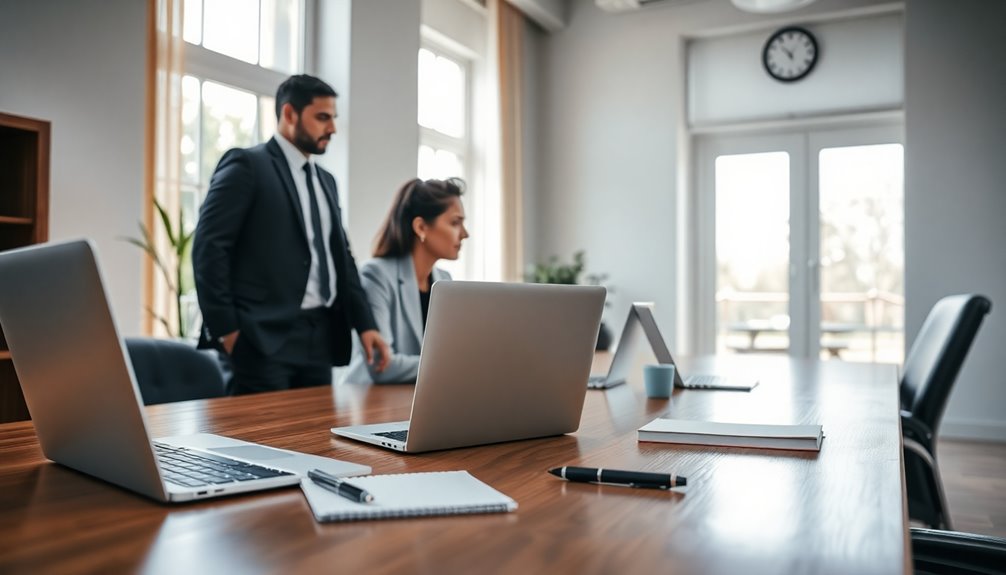
Asking insightful questions during an interview not only demonstrates your interest in the role but also helps you gauge if the company aligns with your values and career goals.
Think about what matters most to you—whether it's company culture, growth opportunities, or work-life balance. You might ask, "Can you describe the team I'll be working with?" or "What does success look like in this position?"
These questions show that you're engaged and thoughtful. Avoid generic inquiries; instead, tailor your questions based on your research about the company.
This approach not only enhances your understanding but also leaves a positive impression on your interviewer, highlighting your enthusiasm and proactive mindset.
Frequently Asked Questions
What Do You Know About Our Company?
You've done your homework about the company, which shows your interest.
You know it was founded in [year] and specializes in [products/services].
You appreciate its commitment to [core values or mission], and you've read about recent initiatives, like [specific project or achievement].
You're excited about the opportunity to contribute to a team that prioritizes [specific aspect of **company culture**], and you believe your skills can help drive its mission forward.
Why Should We Hire You Over Other Candidates?
When you're asked why you should be hired over other candidates, focus on your unique skills and experiences.
Highlight specific strengths that align with the job requirements. Share a relevant example of how you've successfully tackled challenges in the past.
Show your enthusiasm for the role and company culture. Emphasize your willingness to learn and adapt, making it clear that you're ready to contribute positively to the team.
Describe a Time You Showed Leadership Skills
When you think of a time you showcased strong leadership skills, recall a project where you rallied your team.
Perhaps you facilitated focused discussions, fostering collaboration and creativity. You might've delegated tasks effectively, ensuring everyone felt valued and engaged.
When challenges arose, you calmly coordinated solutions, demonstrating decisiveness and dedication.
Ultimately, your guidance led to a successful outcome, leaving a lasting impression on your peers and proving your potential as a leader.
How Do You Prioritize Tasks in a Busy Environment?
When you prioritize tasks in a busy environment, you start by listing everything that needs attention.
Then, you assess deadlines and the importance of each task. You might use tools like to-do lists or apps to keep track.
Focus on high-impact tasks first, and break larger projects into manageable steps.
Remember to stay flexible, as priorities can shift, and adjust your plan accordingly to stay on track and meet your goals.
What Are Your Hobbies and Interests Outside of Work?
When you think about your hobbies and interests, imagine them as vibrant threads weaving through your life's tapestry.
You're passionate about photography, capturing moments like a painter with a brush.
You also enjoy hiking, feeling the earth beneath your feet, and discovering new trails.
These pursuits not only recharge you but also spark creativity, allowing you to bring fresh ideas into your work.
They're an essential part of who you are!
Conclusion
As you step into the interview room, remember that every question is a chance to showcase your unique story. Embrace your strengths, acknowledge your weaknesses, and let your passion shine through. Imagine landing that dream job—it's closer than you think! By preparing thoughtfully and engaging authentically, you can turn nervousness into confidence. So take a deep breath, trust in your abilities, and seize the opportunity to make a lasting impression. Your future is waiting!
Eugene brings a fresh, dynamic voice to our platform as one of our talented Writers. Specializing in research-driven content, he explores the latest findings in psychology and personal growth, translating them into actionable insights for our readers. Eugene’s work is fueled by a curiosity about what makes us tick and a desire to help others unlock their potential.
Job Interview
Mastering the Art of Introductions
Introducing individuals effectively can transform your networking experience; discover the key techniques that will elevate your interactions and leave a lasting impact.

Mastering the art of introductions can greatly enhance your connections in both professional and casual settings. Start by clearly stating your intent and mentioning names, along with a brief relevance description of each person. Maintain eye contact and use a firm handshake to show respect. Remember to adapt your tone based on the context—formal for work, relaxed for social gatherings. Keeping your introductions concise and focused helps spark conversation. Finally, be mindful of cultural differences in etiquette. By applying these techniques, you'll not only make lasting impressions but also foster deeper relationships. There's much more to explore to perfect your skills.
Key Takeaways
- Clearly state your intent, introducing both parties with names and relevant context to foster engagement and connection.
- Maintain eye contact and speak clearly, using a firm handshake if appropriate to convey respect and confidence.
- Adapt your tone and language based on the setting, using formal titles in professional environments and first names in casual settings.
- Be mindful of cultural differences; adjust your introduction style according to customs, such as handshakes or bows.
- Follow up after introductions to nurture relationships, showing genuine interest and facilitating ongoing conversation.
Understanding Introductions

Introductions are often the first step in building relationships, whether in social or professional settings. They set the tone for your interactions and create opportunities for meaningful connections.
When you introduce yourself or someone else, you're not just stating names; you're clarifying identities and relevance. This simple act helps break the ice, making it easier for everyone involved to engage in conversation.
Introductions also foster a sense of comfort, especially in unfamiliar environments. They can create positive first impressions and pave the way for lasting relationships. Moreover, effective introductions can lead to strengthening emotional connections, enhancing the overall quality of your interactions.
Steps for Effective Introductions

Making a strong introduction is essential for establishing connections and fostering communication. Start by clearly stating your intent to introduce both parties. Mention the name of the person you're introducing first, followed by a brief description to highlight their relevance.
Maintain eye contact with both individuals, and speak slowly and clearly to guarantee everyone understands. A firm handshake can add a touch of respect, so don't hesitate to offer one if appropriate.
Remember to pronounce names correctly; it shows you care. Finally, keep it concise—focus on relevant details that will spark conversation and create a positive first impression.
Following these steps will help you navigate introductions with confidence and ease.
Professional vs. Casual Scenarios

Steering introductions in different contexts can greatly impact how connections are formed.
In professional scenarios, it's important to maintain a level of formality. Use titles and last names, and introduce the lower-ranking individual to the higher-ranking one. This shows respect and acknowledges hierarchy.
In casual settings, you can relax the formality. First names are often enough, and you usually introduce the less familiar person to someone more familiar. This approach fosters comfort and inclusivity.
Be mindful of your tone and language; adapt them to fit the situation. Understanding these distinctions guarantees you make a positive impression, whether you're in a boardroom or at a casual gathering.
Tailoring your introductions helps create meaningful connections.
Key Communication Techniques

Effective communication techniques are essential whenever you're introducing individuals. Start by making eye contact with both people, showing you're engaged. Clearly pronounce names to avoid confusion, and keep your speech at a moderate pace for clarity.
Use concise, relevant information about each person to establish their significance. This not only aids understanding but also keeps the introduction professional. Avoid filler words, as they can detract from your message. Additionally, being emotionally intelligent during introductions can help create a more positive atmosphere, as it reflects strong communication skills. Incorporating mindfulness techniques can also enhance your presence and attentiveness during introductions.
Be aware of hierarchy and context; introduce the lower-ranking person to the higher-ranking one, for example. Finally, guarantee the individual being introduced feels comfortable and clarify the reason for the introduction if needed. Additionally, recognizing signs of stagnation in conversations can help you navigate and enhance the dynamics of your introductions.
These techniques will enhance your introductions and foster meaningful connections.
Importance of Context

When it comes to introductions, context plays an essential role in shaping how individuals perceive each other. You need to be aware of the environment, the relationship between the people involved, and the purpose of the introduction. This awareness helps you tailor your approach, ensuring that everyone feels comfortable and respected. Understanding the importance of communication can further enhance your introductions by fostering a sense of connection right from the start. Additionally, recognizing how foster parent pay varies can inform discussions in contexts where parenting resources are relevant. Establishing a clear understanding of co-parenting plans can also contribute to more effective introductions within family dynamics. Moreover, being mindful of emotional dysregulation can assist in navigating interactions with individuals who may have varying emotional responses.
| Context Type | Key Considerations | Expected Behavior |
|---|---|---|
| Professional | Hierarchy and roles | Use titles, formal tone |
| Casual | Familiarity | First names, relaxed tone |
| Networking | Purpose and relevance | Concise, engaging details |
| Client Meeting | Respect and relationship | Address client first |
| Social Gathering | Group dynamics | Introduce less familiar first |
Cultural Considerations
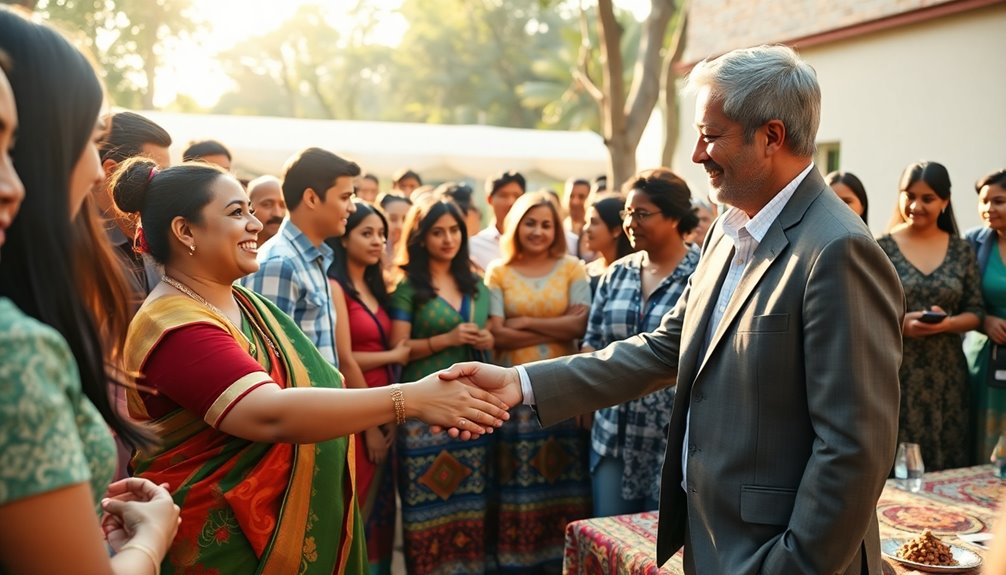
Maneuvering cultural considerations in introductions can make all the difference in how people connect. When you introduce someone from a different culture, it's essential to understand their customs and etiquette.
For instance, some cultures emphasize formal titles and hierarchy, while others favor a more casual approach. You should also be aware of non-verbal cues, like eye contact and gestures, which can vary widely. In some cultures, a handshake is standard, while in others, bowing or even a nod might be more appropriate.
Always ask questions if you're uncertain about preferences. By respecting these cultural nuances, you help foster an environment of respect and understanding, paving the way for more meaningful interactions.
Building Lasting Connections

Building lasting connections is essential in both personal and professional domains. You can strengthen these bonds through intentional interactions and genuine interest.
Focus on creating memorable experiences by:
- Listening actively to what others share
- Finding common interests to spark deeper conversations
- Following up with a quick message or email
- Engaging in shared activities or networking events
- Showing appreciation for their time and insights
- Understanding the importance of data security in maintaining trust within relationships.
When you invest in these connections, you pave the way for collaboration and support. Additionally, fostering secure attachment bonds can enhance the depth of your relationships, transforming them into meaningful partnerships. Establishing strong communication skills can further enhance these connections, enabling clearer exchanges and fostering trust. Furthermore, nurturing emotional alignment during interactions can significantly improve the quality of your relationships.
Frequently Asked Questions
How Do I Introduce Someone With a Difficult Name?
When you need to introduce someone with a difficult name, take a moment to pronounce it clearly first.
You can say, "I'd like you all to meet [Name]. It's pronounced [Phonetic Breakdown]." This not only helps others but shows respect for the individual.
Maintain eye contact and speak slowly, ensuring everyone understands. If necessary, don't hesitate to repeat the name or encourage the person to share how they prefer it to be pronounced.
What if I Forget Someone's Name During an Introduction?
Did you know that nearly 50% of people forget names shortly after hearing them?
If you forget someone's name during an introduction, don't panic. Acknowledge the mistake gracefully and ask for their name again. You might say, "I'm sorry, I didn't catch your name."
This shows honesty and can often ease any awkwardness. Plus, most people appreciate the effort you make to remember them, strengthening your connection.
Is It Appropriate to Introduce Myself First?
Yes, it's perfectly appropriate to introduce yourself first, especially in casual settings.
Starting with your name can break the ice and make others feel more comfortable. Just remember to maintain eye contact and use a friendly tone.
If you're in a professional environment, consider the hierarchy and introduce the higher-ranking individual first.
Regardless of the context, your confident introduction sets a positive tone for the conversation ahead.
How Do I Handle Awkward Silences After an Introduction?
You've just made an introduction, and suddenly, an awkward silence looms.
Don't panic! Instead, break the ice by asking an open-ended question related to the context or interests of the people involved.
Share a fun fact or an anecdote to get the conversation flowing again.
You could also comment on your surroundings or find common ground.
What Should I Do if Someone Interrupts an Introduction?
If someone interrupts an introduction, stay calm and composed.
You can politely acknowledge the interruption by nodding or smiling.
Then, gently redirect the conversation back to the introduction by saying something like, "As I was saying, I'd like you to meet…"
This way, you keep the focus on the individuals involved.
Remember, interruptions happen, so don't take it personally.
Just maintain your poise and guarantee everyone feels included.
Conclusion
As you step into your next gathering, remember that every introduction is a door to new possibilities. By applying the techniques outlined in this guide, you'll not only create connections but also plant seeds for future relationships. So, embrace the art of introductions—it's not just about names, but about weaving a network of understanding and camaraderie. After all, in the tapestry of life, each thread you weave can lead to the most unexpected and beautiful patterns.
Eugene brings a fresh, dynamic voice to our platform as one of our talented Writers. Specializing in research-driven content, he explores the latest findings in psychology and personal growth, translating them into actionable insights for our readers. Eugene’s work is fueled by a curiosity about what makes us tick and a desire to help others unlock their potential.
-

 Love Compatibility between Zodiac Signs1 month ago
Love Compatibility between Zodiac Signs1 month agoRat Compatibility in the Chinese Zodiac: Which Signs Are the Perfect Match?
-

 Love Compatibility between Zodiac Signs2 months ago
Love Compatibility between Zodiac Signs2 months agoThe Ultimate Guide to Throuple Zodiac Compatibility
-

 Love Compatibility between Zodiac Signs2 months ago
Love Compatibility between Zodiac Signs2 months ago10 Mother-Daughter Zodiac Combinations That Have Natural Compatibility
-

 Love Compatibility between Zodiac Signs2 months ago
Love Compatibility between Zodiac Signs2 months agoHow to Assess Snake Compatibility in the Chinese Zodiac
-

 Love Compatibility between Zodiac Signs4 weeks ago
Love Compatibility between Zodiac Signs4 weeks agoCat Zodiac Compatibility: Which Signs Are Most Compatible With Cats?
-

 Love Compatibility between Zodiac Signs3 months ago
Love Compatibility between Zodiac Signs3 months agoBTS Zodiac Signs Compatibility: A Guide to Their Ideal Matches
-

 Love Compatibility between Zodiac Signs3 weeks ago
Love Compatibility between Zodiac Signs3 weeks agoDiscover Your Family's Zodiac Compatibility With This Calculator
-

 Childfree3 months ago
Childfree3 months ago10 Reasons Why Being Childfree Is Empowering









